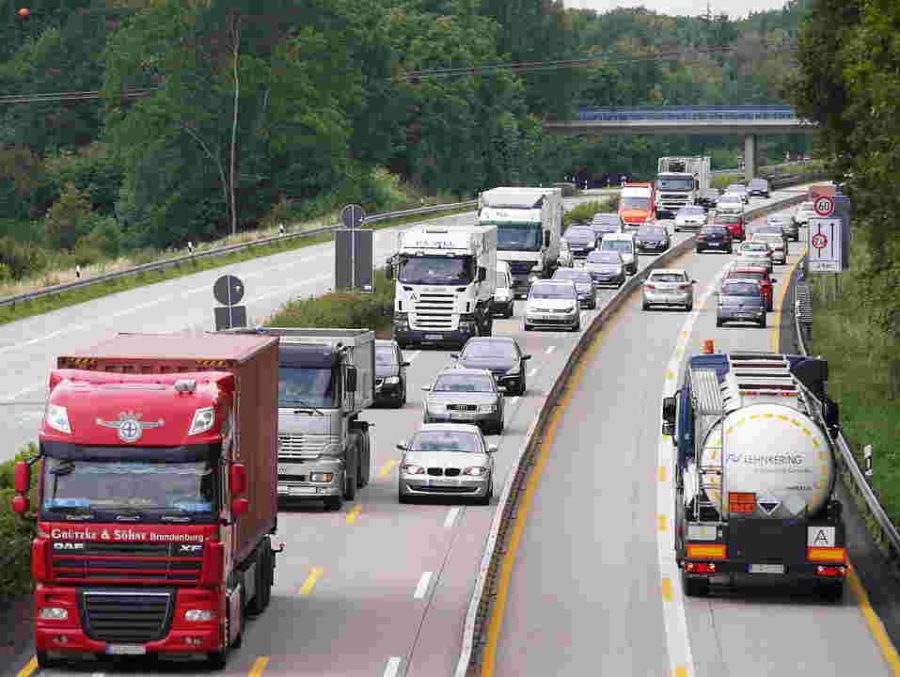What Makes a Semi Truck Accident Different?
The laws of nature have as much to do with semi truck and car accidents as do the laws of the land. It’s Newton’s Third Law: in a collision of a big object and a small object, the smaller one will experience the greater change in momentum and sustain the greater damage. In other words, in a […]

June 15, 2016
 The laws of nature have as much to do with semi truck and car accidents as do the laws of the land.
The laws of nature have as much to do with semi truck and car accidents as do the laws of the land.
It’s Newton’s Third Law: in a collision of a big object and a small object, the smaller one will experience the greater change in momentum and sustain the greater damage. In other words, in a head-on collision between a semi truck and a passenger vehicle, the passenger vehicle – including its driver and passengers – will typically sustain the worst injuries.
The traumatic effects resulting from the typical car vs. semi accident include:
- Amputations
- Paralysis
- Brain damage
- Death
Highway accidents involving semis kill about 5,000 people per year, Anne Balay and Mona Shattell report in the recent New York Times article “Long-Haul Sweatshops.”
 Semi truck accidents aren’t handled the same way as collisions involving only passenger vehicles. For one thing, when a semi truck is involved, there are five different parties that may be held liable for negligence:
Semi truck accidents aren’t handled the same way as collisions involving only passenger vehicles. For one thing, when a semi truck is involved, there are five different parties that may be held liable for negligence:
- The truck driver
- The trucking company
- The truck manufacturer
- The company that loaded the truck
- The company responsible for maintaining the truck
When Indiana personal injury attorneys are engaged to represent the driver and passengers in a vehicle that was involved in a semi truck accident, they are working to obtain compensation for any or all of the following:
- Medical expenses
- Lost wages
- Pain and suffering
- Funeral and burial expenses
- Loss of spousal support
- Loss of parental guidance
A number of different organizations and agencies gather data about semi truck accidents in the United States:
- The National Highway Traffic Safety Administration uses FARS (Fatality Analysis Reporting System) to compile a census of fatal crashes on public trafficways. In FARS, a large truck is defined as a vehicle weighing more than 10,000 pounds.
- The Motor Carrier Management Information System (MMIS) maintains a Crash File. The system records crashes involving commercial trucks and buses resulting in a minimum of either one fatality, or one injury requiring immediate medical attention away from the crash scene.
- The Office of Highway Policy Information publishes Highway Statistics, which reports data on licensing and highway finance.
Despite this diligent tracking of statistics about personal injuries caused by crashes involving semis, Balay and Shattell assert that the government’s emphasis has been in the wrong area, almost entirely focused on road safety. That focus, they explain, overlooks one critical concern: the well-being of the semi drivers themselves.
Driving a semi truck involves a great deal of skill and focus, Professor Balay, a former long-haul trucker, explains. Truckers rightfully take pride in their work because:
- Floating the semi’s gears takes good coordination and timing
- Maneuvering the 10,000 pound bulk takes visual perceptiveness and courage
- Surviving weather, mountains, and construction zones is difficult
- Enduring “cultural scorn” and boredom takes toughness
The other side of the story is worrisome, to say the least, The New York Times points out.
Drivers are regulated by the Department of Transportation, not the Department of Labor. Why is that significant? The government imposes rules meant to keep roads safe, but those rules leave drivers exposed to “inhumane and demeaning work conditions that come from abusive surveillance and micromanaging.”
 A trucker’s work week can be as long as 82 hours
A trucker’s work week can be as long as 82 hours- Drivers work 14-hour days, often without weekends off
- Eleven of the fourteen hours are spent in actual driving; the remainder of the time is used for truck loading and maintenance
- Drivers often receive no sick pay or holiday pay
- So long as a driver is not actually behind the wheel, their employers can require them to perform other work rather than allowing them to rest
Rather than improving the conditions of the semi drivers, the industry has tried to use technology for intrusive surveillance of drivers.
- “Governed speed” renders the truck incapable of exceeding a certain speed
- Sensors automatically brake if the space from the front of a truck to the back of the vehicle ahead is deemed insufficient
- 2-way cameras are trained on truck drivers
- Drivers suffering from sleep apnea are forced to use CPAP machines in their trucks while idling the engine
This burdensome maltreatment, in Balay and Shattell’s opinion, is forcing experienced workers to leave the trucking industry, which then forces employers to hire younger and less capable drivers.
And, of course, that leaves passenger vehicles extremely vulnerable to tragedy-causing collisions. The American Trucking Association itself says that truck crashes are more likely to result in fatalities than accidents involving only cars.
“At any given time on the highway, many different factors interact to affect risk, and many different types of failures can result in a crash,” the ATA admits. Crash factors and causes are classified as:
- Human (driver)
- Vehicle
- Environmental (roadway and weather)
The ATA seems to reinforce Balay and Shattell’s conclusions in saying that, “In about 9 out of 10 crashes, the primary failure is driver error.” These “Critical Reasons” or CRs, (on the part of both the drivers of semis and drivers of passenger vehicles), include:
about 9 out of 10 crashes, the primary failure is driver error.” These “Critical Reasons” or CRs, (on the part of both the drivers of semis and drivers of passenger vehicles), include:
- Driving too fast for the conditions
- Improper following
- Failure to keep in lane
When you have been injured in any accident, all your energies are naturally focused on trying to put your life back together, with one of the biggest concerns being the financial help you need. In a semi truck vs. passenger vehicle accident, because of the effect of Newton’s Third Law, the type and duration of injuries is likely to be extensive.
Many components of the accident itself will need to be investigated, documented, and evaluated, including:
- The type and duration of the injury you’ve suffered
- The financial costs you’ve incurred to date
- The type of mental and/or medical treatment you are expected to need in the future
- How much insurance coverage you have
And, on top of that, comparative fault will need to be negotiated (the extent, if any, to which the accident was in any measure due to your own driver error).
Accidentsinus.com, a website that lists all road accidents in Indiana, reported no fewer than four accidents – in March 2016 alone – involving semi trucks.
What makes a semi truck accident different? In a collision of a big object and a small object, the smaller object will experience the greater change in momentum and sustain the greater damage. That’s why accidents involving semi trucks are particularly dangerous for the drivers and riders in passenger vehicles.
Available 24/7
Free Case Review
You won’t pay any fees until we win your case.
It’s easy - you can: